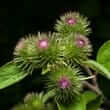Background
- Burdock has historically been used to treat a wide variety of ailments, including arthritis, diabetes, and hair loss. It is a principal herbal ingredient in the popular cancer remedies Essiac® (rhubarb, sorrel, slippery elm) and Hoxsey formula (red clover, poke, prickly ash, bloodroot, barberry).
- Burdock fruit has been found to lower blood sugar in animals, and early human studies have examined burdock root in diabetes. Laboratory and animal studies have explored the use of burdock for bacterial infections, cancer, HIV, and kidney stones. However, there is currently insufficient human evidence regarding the efficacy of burdock for any indication.
References
Natural Standard developed the above evidence-based information based on a thorough systematic review of the available scientific articles. For comprehensive information about alternative and complementary therapies on the professional level, go to . Selected references are listed below.
- Anonymous. In vitro screening of traditional medicines for anti-HIV activity: memorandum from a WHO meeting. Bull World Health Organ 1989;67(6):613-618.
- Flickinger EA, Hatch TF, Wofford RC, et al. In vitro fermentation properties of selected fructooligosaccharide-containing vegetables and in vivo colonic microbial populations are affected by the diets of healthy human infants. J Nutr 2002;132(8):2188-2194.
View Abstract - Grases F, Melero G, Costa-Bauza A, et al. Urolithiasis and phytotherapy. Int Urol Nephrol 1994;26(5):507-511.
View Abstract - Holetz FB, Pessini GL, Sanches NR, et al. Screening of some plants used in the Brazilian folk medicine for the treatment of infectious diseases. Mem Inst Oswaldo Cruz 2002;97(7):1027-1031.
View Abstract - Iwakami S, Wu JB, Ebizuka Y, et al. Platelet activating factor (PAF) antagonists contained in medicinal plants: lignans and sesquiterpenes. Chem Pharm Bull (Tokyo) 1992;40(5):1196-1198.
View Abstract - Lin CC, Lu JM, Yang JJ, et al. Anti-inflammatory and radical scavenge effects of Arctium lappa. Am J Chin Med 1996;24(2):127-137.
View Abstract - Lin SC, Chung TC, Lin CC, et al. Hepatoprotective effects of Arctium lappa on carbon tetrachloride- and acetaminophen-induced liver damage. Am J Chin Med 2000;28(2):163-173.
View Abstract - Lin SC, Lin CH, Lin CC, et al. Hepatoprotective effects of Arctium lappa Linne on liver injuries induced by chronic ethanol consumption and potentiated by carbon tetrachloride. J Biomed Sci 2002;9(5):401-409.
View Abstract - Morita K, Kada T, Namiki M. A desmutagenic factor isolated from burdock (Arctium lappa Linne). Mutat Res 1984;129(1):25-31.
View Abstract - Os'kina OA, Pashinskii VG, Kanakina TA, et al. [The mechanisms of the anti-ulcer action of plant drug agents]. Eksp Klin Farmakol 1999;62(4):37-39.
View Abstract - Rodriguez P, Blanco J, Juste S, et al. Allergic contact dermatitis due to burdock (Arctium lappa). Contact Dermatitis 1995;33(2):134-135.
View Abstract - Sasaki Y, Kimura Y, Tsunoda T, et al. Anaphylaxis due to burdock. Int J Dermatol 2003;42(6):472-473.
View Abstract - Swanston-Flatt SK, Day C, Flatt PR, et al. Glycaemic effects of traditional European plant treatments for diabetes. Studies in normal and streptozotocin diabetic mice. Diabetes Res 1989;10(2):69-73.
View Abstract - Yang L, Lin S, Yang T, et al. Synthesis of anti-HIV activity of dibenzylbutyrolactone lignans. Bioorganic Medicinal Chem Lett 1996;6:941-944.
- Zick SM, Sen A, Feng Y, et al. Trial of Essiac to ascertain its effect in women with breast cancer (TEA-BC). J Altern Complement Med 2006 Dec;12(10):971-80.
View Abstract







